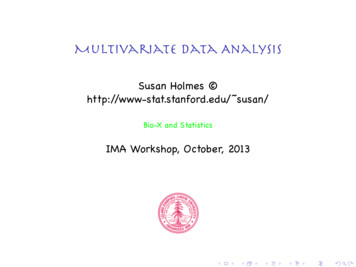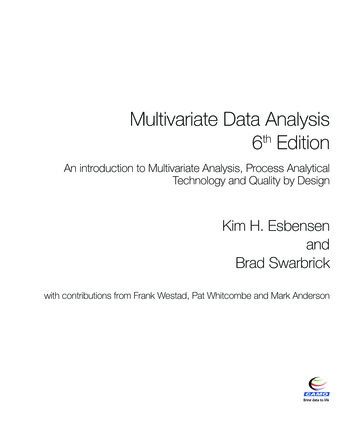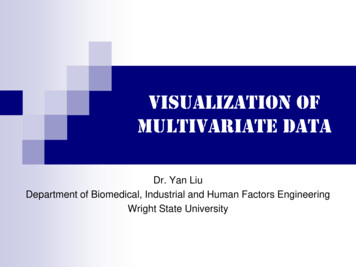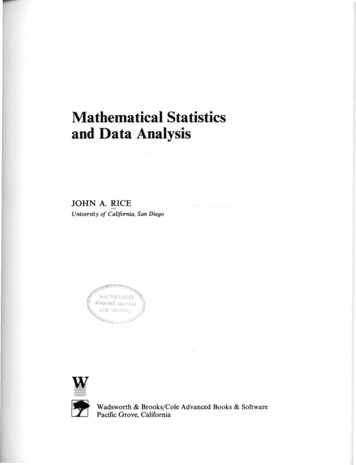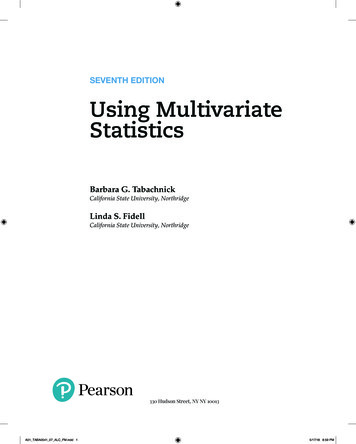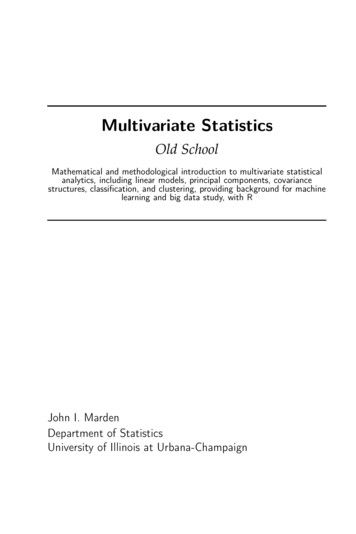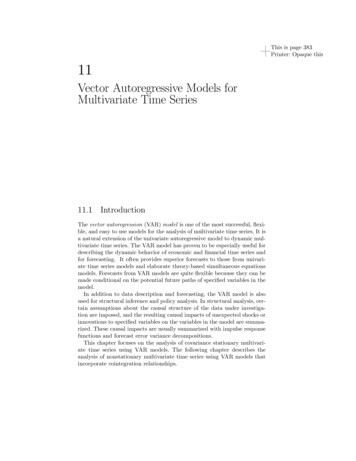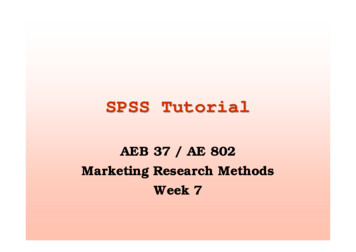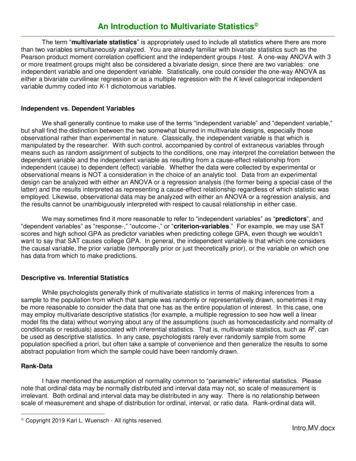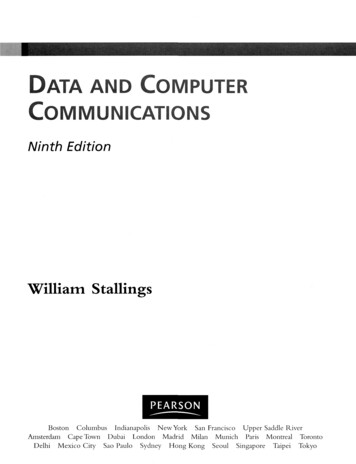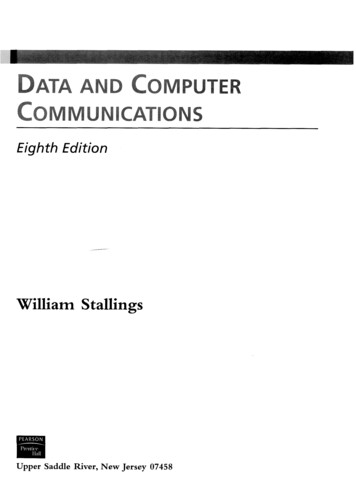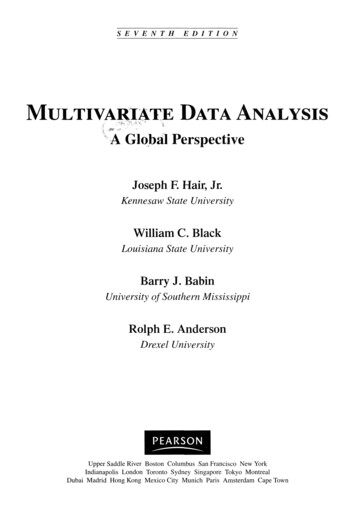
Transcription
SEVENTHEDITIONMULTIVARIATE DATA ANALYSISi. - * . ' . . '-4A Global PerspectiveJoseph F. Hair, Jr.Kennesaw State UniversityWilliam C. BlackLouisiana State UniversityBarry J. BabinUniversity of Southern MississippiRolph E. AndersonDrexel UniversityUpper Saddle River Boston Columbus San Francisco New YorkIndianapolis London Toronto Sydney Singapore Tokyo MontrealDubai Madrid Hong Kong Mexico City Munich Paris Amsterdam Cape Town
CONTENTSPrefacexxvAbout the AuthorsxxviiChapter 1 Introduction: Methods and Model Building1What Is Multivariate Analysis? 3Multivariate Analysis in Statistical Terms 4Some Basic Concepts of Multivariate Analysis 4The Variate 4Measurement Scales5Measurement Error and Multivariate MeasurementStatistical Significance Versus Statistical Power 8Types of Statistical Error and Statistical Power79Impacts on Statistical Power 9Using Power with Multivariate Techniques 11A Classification of Multivariate Techniques 11Dependence Techniques14Interdependence Techniques 14Types of Multivariate Techniques 15Principal Components and Common Factor AnalysisMultiple Regression1616Multiple Discriminant Analysis and Logistic RegressionCanonical Correlation1617Multivariate Analysis of Variance and CovarianceConjoint Analysis 1817Cluster Analysis 18Perceptual Mapping 19Correspondence Analysis19Structural Equation Modeling and Confirmatory FactorAnalysis 19Guidelines for Multivariate Analyses and Interpretation 20Establish Practical Significance as Well as StatisticalSignificance 20Recognize That Sample Size Affects All ResultsKnow Your Data 21Strive for Model Parsimony2121Look at Your Errors 22Validate Your Results 22A Structured Approach to Multivariate Model Building22ix
Stage 1: Define the Research Problem, Objectives,and Multivariate Technique to Be Used 23Stage 2: Develop the Analysis Plan 23Stage 3: Evaluate the Assumptions Underlying the MultivariateTechnique 23Stage 4: Estimate the Multivariate Model and Assess OverallModel Fit 23Stage 5: Interpret the Variate(s) 24Stage 6: Validate the Multivariate Model 24A Decision Flowchart24Databases 24Primary Database 25Other Databases 27Organization of the Remaining Chapters 28Section I: Understanding and Preparing For Multivariate AnalysisSection II: Analysis Using Dependence Techniques 28Section III: Interdependence Techniques 28Section IV: Structural Equations Modeling 28SummaryReferencesSECTION I28 Questions30 Suggested Readings3030Understanding a n d Preparing For M u l t i v a r i a t eAnalysis31Chapter 2 Cleaning and Transforming DataIntroduction 36Graphical Examination of the Data3337Univariate Profiling: Examining the Shape of theDistribution 38Bivariate Profiling: Examining the Relationship BetweenVariables 39Bivariate Profiling: Examining Group DifferencesMultivariate Profiles 41Missing Data 42The Impact of Missing Data4042A Simple Example of a Missing Data Analysis43A Four-Step Process for Identifying Missing Data and ApplyingRemedies 44An Illustration of Missing Data Diagnosis withthe Four-Step Process 54Outliers64Detecting and Handling Outliers65An Illustrative Example of Analyzing Outliers 68Testing the Assumptions of Multivariate Analysis 70
ContentsAssessing Individual Variables Versus the VariateFour Important Statistical Assumptions7071Data Transformations 77An Illustration of Testing the Assumptions UnderlyingMultivariate Analysis 79Incorporating Nonmetric Data with Dummy Variables 86SummaryReferencesChapter 388 Questions89 Suggested Readings8990Factor Analysis91What Is Factor Analysis? 94A Hypothetical Example of Factor AnalysisFactor Analysis Decision Process9596Stage 1: Objectives of Factor Analysis96Specifying the Unit of Analysis 98Achieving Data Summarization Versus Data ReductionVariable Selection 9998Using Factor Analysis with Other Multivariate TechniquesStage 2: Designing a Factor Analysis 100100Correlations Among Variables or Respondents 100Variable Selection and Measurement Issues 101Sample Size 102Summary 102Stage 3: Assumptions in Factor Analysis103Conceptual Issues 103Statistical Issues 103Summary 104Stage 4: Deriving Factors and Assessing Overall Fit105Selecting the Factor Extraction Method 105Criteria for the Number of Factors to Extract 108Stage 5: Interpreting the Factors 112The Three Processes of Factor Interpretation112Rotation of Factors 113Judging the Significance of Factor Loadings116Interpreting a Factor Matrix 118Stage 6: Validation of Factor Analysis122Use of a Confirmatory Perspective122Assessing Factor Structure Stability122Detecting Influential Observations 123Stage 7: Additional Uses of Factor Analysis Results 123Selecting Surrogate Variables for Subsequent AnalysisCreating Summated Scales124123xi
Computing Factor Scores 127Selecting Among the Three MethodsAn Illustrative Example 129128Stage 1: Objectives of Factor Analysis 129Stage 2: Designing a Factor Analysis 129Stage 3: Assumptions in Factor Analysis 129Component Factor Analysis: Stages 4 Through 7Common Factor Analysis: Stages 4 and 5 144A Managerial Overview of the Results 146SummaryReferences148 Questions150 132Suggested Readings150150SECTION II Analysis Using Dependence TechniquesChapter 4 Simple and Multiple Regression153155What Is Multiple Regression Analysis?161An Example of Simple and Multiple Regression162Prediction Using a Single Independent Variable:Simple Regression 162Prediction Using Several Independent Variables:Multiple Regression 165Summary 167A Decision Process for Multiple Regression AnalysisStage 1: Objectives of Multiple Regression 169167Research Problems Appropriate for Multiple RegressionSpecifying a Statistical Relationship 171169Selection of Dependent and Independent Variables 171Stage 2: Research Design of a Multiple Regression Analysis 173Sample Size174Creating Additional Variables 176Stage 3: Assumptions in Multiple Regression AnalysisAssessing Individual Variables Versus the VariateMethods of Diagnosis 183Linearity of the Phenomenon181182183Constant Variance of the Error TermIndependence of the Error Terms185185Normality of the Error Term Distribution 185Summary 186Stage 4: Estimating the Regression Model and Assessing OverallModel Fit 186Selecting an Estimation Technique 186Testing the Regression Variate for Meeting the RegressionAssumptions 191
ContentsExamining the Statistical Significance of Our Modelxiii192Identifying Influential Observations 194Stage 5: Interpreting the Regression Variate 197Using the Regression Coefficients 197Assessing Multicollinearity 200Stage 6: Validation of the Results 206Additional or Split Samples206Calculating the PRESS StatisticComparing Regression Models206206Forecasting with the Model 207Illustration of a Regression Analysis207Stage 1: Objectives of Multiple Regression207Stage 2: Research Design of a Multiple Regression AnalysisStage 3: Assumptions in Multiple Regression Analysis 208Stage 4: Estimating the Regression Model and AssessingOverall Model Fit 208Stage 5: Interpreting the Regression Variate 223Stage 6: Validating the Results226Evaluating Alternative Regression ModelsA Managerial Overview of the ResultsSummaryReferences231 Questions234 227231Suggested Readings234234Chapter 5 Canonical Correlation235What Is Canonical Correlation?237Hypothetical Example of Canonical Correlation238Developing a Variate of Dependent Variables 238Estimating the First Canonical Function 238Estimating a Second Canonical Function 240Relationships of Canonical Correlation Analysis to OtherMultivariate Techniques 241Stage 1: Objectives of Canonical Correlation AnalysisSelection of Variable Sets 242Evaluating Research Objectives 242Stage 2: Designing a Canonical Correlation AnalysisSample Size243Variables and Their Conceptual Linkage243Missing Data and Outliers 244Stage 3: Assumptions in Canonical CorrelationLinearity 244Normality 244Homoscedasticity and Multicollinearity244244242243208
xivContentsStage 4: Deriving the Canonical Functions and AssessingOverall Fit 245Deriving Canonical Functions 246Which Canonical Functions Should Be Interpreted?246Stage 5: Interpreting the Canonical Variate 250Canonical Weights 250Canonical Loadings 250Canonical Cross-Loadings 250Which Interpretation Approach to Use 251Stage 6: Validation and DiagnosisAn Illustrative Example251252Stage 1: Objectives of Canonical Correlation Analysis 253Stages 2 and 3: Designing a Canonical Correlation Analysisand Testing the Assumptions 253Stage 4: Deriving the Canonical Functions and AssessingOverall Fit 253Stage 5: Interpreting the Canonical VariatesStage 6: Validation and Diagnosis257A Managerial Overview of the ResultsSummary258Chapter 6 Conjoint Analysis Questions259254 258References260261What Is Conjoint Analysis?266Hypothetical Example of Conjoint Analysis267Specifying Utility, Factors, Levels, and Profiles 267Gathering Preferences from Respondents 268Estimating Part-Worths 269Determining Attribute Importance 270Assessing Predictive Accuracy 270The Managerial Uses of Conjoint Analysis 271Comparing Conjoint Analysis with Other MultivariateMethods 272Compositional Versus Decompositional TechniquesSpecifying the Conjoint Variate 272Separate Models for Each IndividualFlexibility in Types of Relationships272273Designing a Conjoint Analysis Experiment 273Stage 1: The Objectives of Conjoint Analysis 276Defining the Total Utility of the Object 276Specifying the Determinant Factors276Stage 2: The Design of a Conjoint Analysis277Selecting a Conjoint Analysis Methodology278272
ContentsxvDesigning Profiles: Selecting and Defining Factorsand Levels 278Specifying the Basic Model Form 283Data Collection 286Stage 3: Assumptions of Conjoint Analysis 293Stage 4: Estimating the Conjoint Model and Assessing Overall FitSelecting an Estimation TechniqueEstimated Part-Worths294294297Evaluating Model Goodness-of-Fit 298Stage 5: Interpreting the Results 299Examining the Estimated Part-Worths300Assessing the Relative Importance of Attributes 302Stage 6: Validation of the Conjoint Results 303Managerial Applications of Conjoint Analysis 303Segmentation304Profitability Analysis 304Conjoint Simulators 305Alternative Conjoint Methodologies306Adaptive/Self-Explicated Conjoint: Conjoint witha Large Number of Factors 306Choice-Based Conjoint: Adding Another Touch of Realism308Overview of the Three Conjoint Methodologies 312An Illustration of Conjoint Analysis 312Stage 1: Objectives of the Conjoint Analysis 313Stage 2: Design of the Conjoint AnalysisStage 3: Assumptions in Conjoint Analysis313316Stage 4: Estimating the Conjoint Model and Assessing OverallModel Fit 316Stage 5: Interpreting the Results 320Stage 6: Validation of the Results324A Managerial Application: Use of a Choice SimulatorSummaryReferences327 Questions330 Suggested Readings325330330mChapter 7 M u l t i p l e Discriminant Analysis and Logistic Regression335What Are Discriminant Analysis and Logistic Regression? 339Discriminant Analysis 340Logistic Regression 341Analogy with Regression and MANOVA 341Hypothetical Example of Discriminant Analysis 342A Two-Group Discriminant Analysis: Purchasers VersusNonpurchasers 342
A Geometric Representation of the Two-Group DiscriminantFunction 345A Three-Group Example of Discriminant Analysis: SwitchingIntentions 346The Decision Process for Discriminant Analysis 348Stage 1: Objectives of Discriminant Analysis 350Stage 2: Research Design for Discriminant Analysis351Selecting Dependent and Independent VariablesSample Size 353Division of the Sample 353Stage 3: Assumptions of Discriminant AnalysisImpacts on Estimation and ClassificationImpacts on Interpretation351354354355Stage 4: Estimation of the Discriminant Model and AssessingOverall Fit 356Selecting an Estimation MethodStatistical Significance 358Assessing Overall Model Fit356359Casewise Diagnostics 368Stage 5: Interpretation of the ResultsDiscriminant WeightsDiscriminant LoadingsPartial F Values 370369369370Interpretation of Two or More Functions370Which Interpretive Method to Use? 373Stage 6: Validation of the Results 373Validation Procedures 373Profiling Group Differences 374A Two-Group Illustrative Example 375Stage 1: Objectives of Discriminant AnalysisStageStageStageand3752: Research Design for Discriminant Analysis 3753: Assumptions of Discriminant Analysis 3764: Estimation of the Discriminant ModelAssessing Overall Fit 376Stage 5: Interpretation of the ResultsStage 6: Validation of the Results387390A Managerial Overview 391A Three-Group Illustrative Example 391Stage 1: Objectives of Discriminant Analysis391Stage 2: Research Design for Discriminant AnalysisStage 3: Assumptions of Discriminant Analysis392392
ContentsxviiStage 4: Estimation of the Discriminant Model and AssessingOverall Fit 392Stage 5: Interpretation of Three-Group Discriminant AnalysisResults 404Stage 6: Validation of the Discriminant Results 410A Managerial Overview 412Logistic Regression: Regression with a Binary DependentVariable 413Representation of the Binary Dependent Variable414Sample Size 415Estimating the Logistic Regression Model 416Assessing the Goodness-of-Fit of the Estimation ModelTesting for Significance of the CoefficientsInterpreting the Coefficients419421422Calculating Probabilities for a Specific Value of the IndependentVariable 425Overview of Interpreting Coefficients 425Summary 425An Illustrative Example of Logistic Regression426Stages 1, 2, and 3: Research Objectives, Research Design,and Statistical Assumptions 426Stage 4: Estimation of the Logistic Regression Modeland Assessing Overall Fit 426Stage 5: Interpretation of the Results 432Stage 6: Validation of the ResultsA Managerial OverviewSummaryReferences434 433434Questions437 Suggested Readings437437Chapter 8 ANOVA and MANOVA439MANOVA: Extending Univariate Methods for Assessing GroupDifferences 443Multivariate Procedures for Assessing Group DifferencesA Hypothetical Illustration of MANOVA 447Analysis Design 447Differences from Discriminant Analysis448Forming the Variate and Assessing DifferencesA Decision Process for MANOVA 449Stage 1: Objectives
SEVENTH EDITION MULTIVARIATE DATA ANALYSIS i .-*.'. . ' -4 A Global Perspective Joseph F. Hair, Jr. Kennesaw State University William C. Black Louisiana State University Barry J. Babin University of Southern Mississippi Rolph E. Anderson Drexel University Upper Saddle River Boston Columbus San Francisco New York Indianapolis London Toronto Sydney Singapore Tokyo Montreal .
